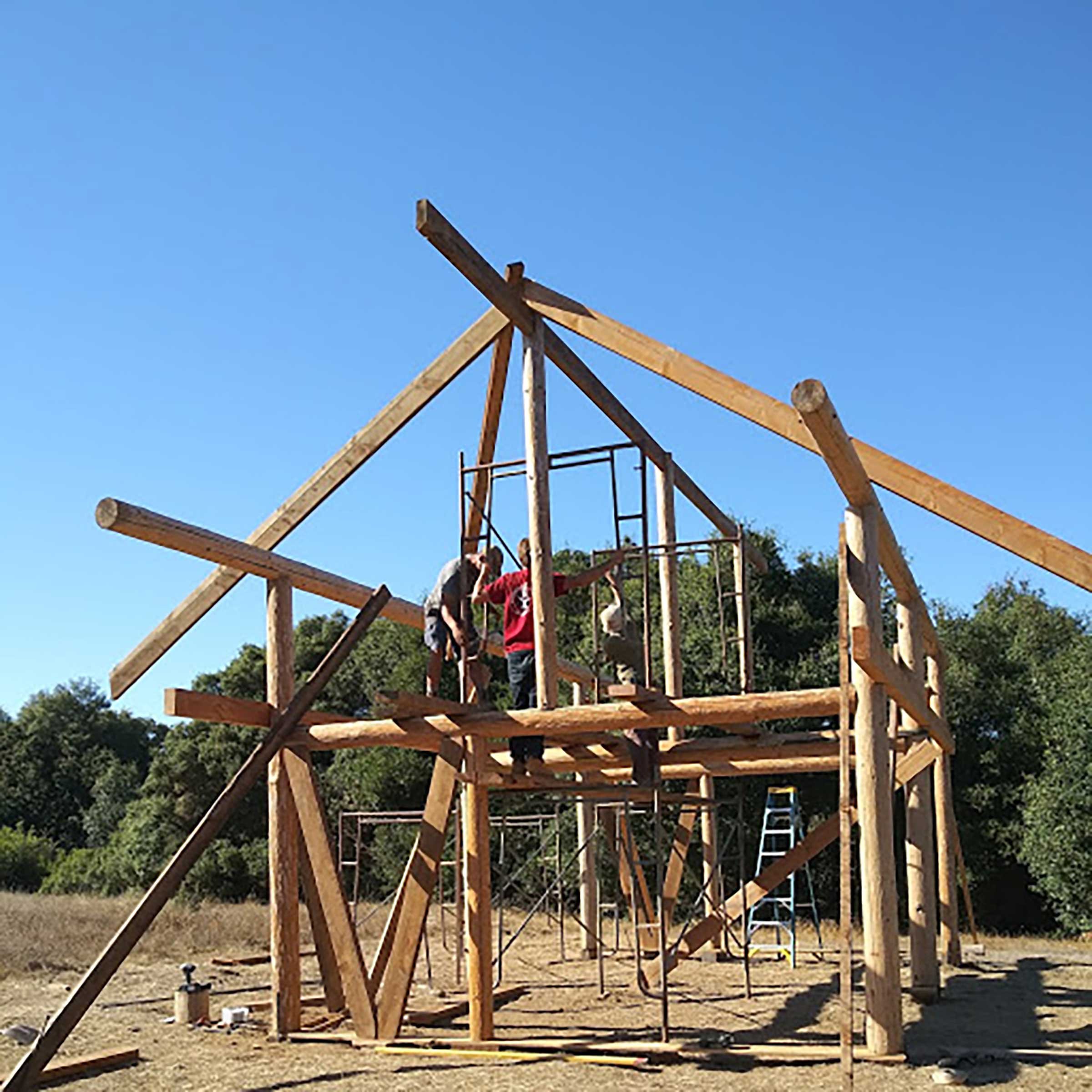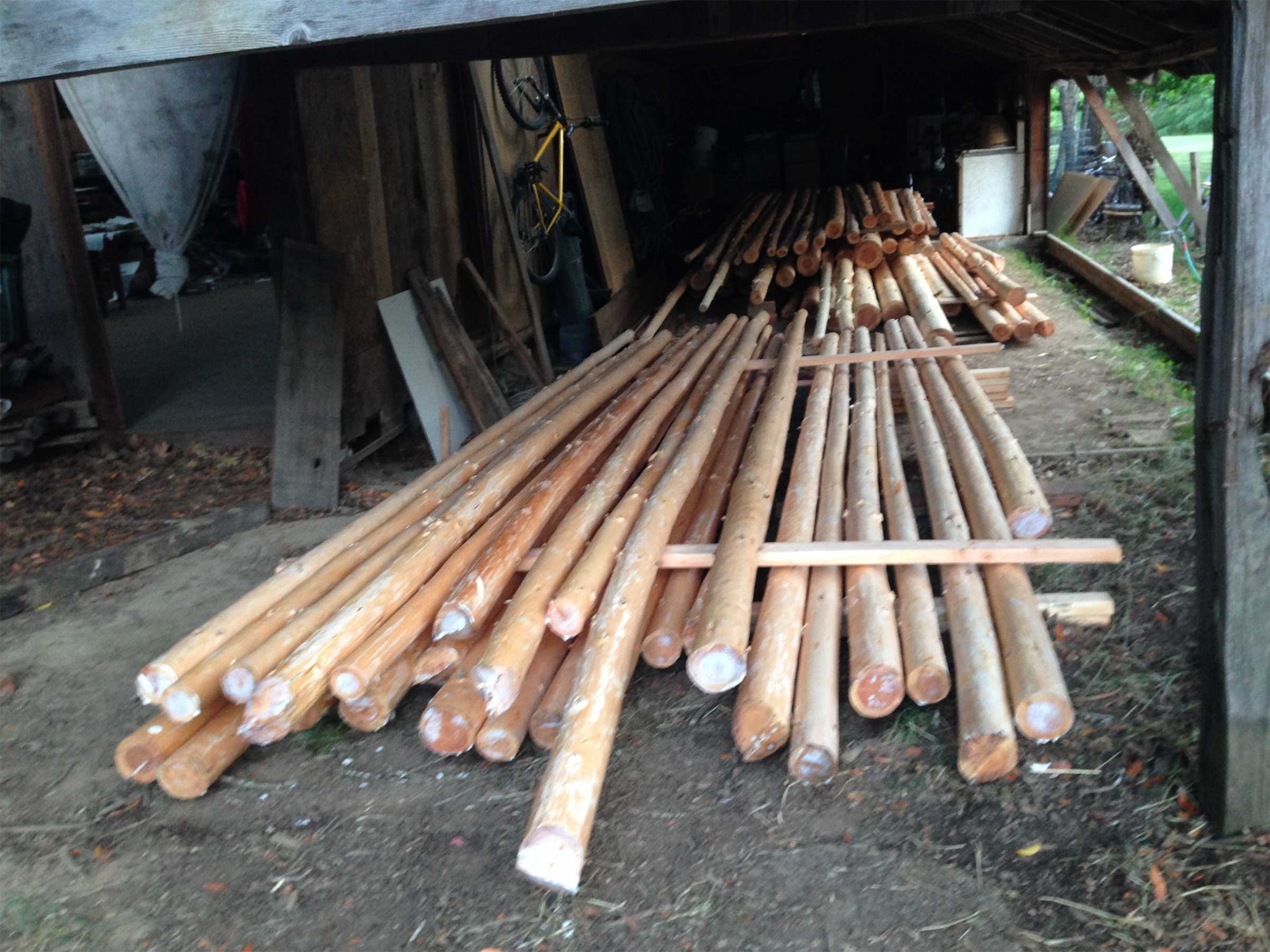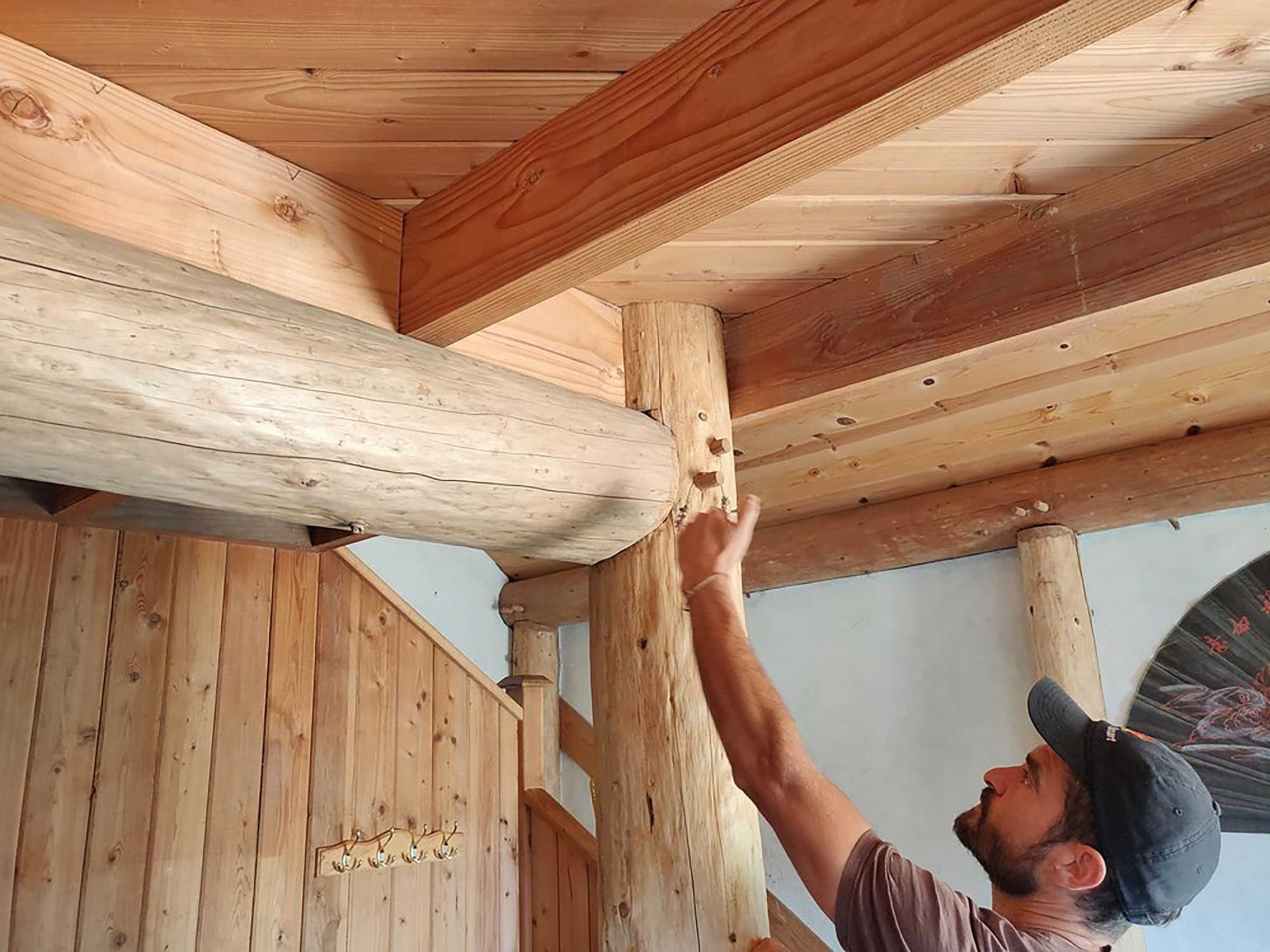Starving Fire and Building Homes

How Round Pole Construction Can Improve Forests, Create Jobs, and Shelter Humans
by Torrey Douglass
When Colin Gillespie moved to Mendocino County in 1998, he encountered a lot of people looking to thin small diameter trees from their land to increase sunlight and decrease fire risk. At the time, he was shifting away from landscaping work, which included simple construction projects like fencing and gazebos. He moved into more traditional construction, which, combined with his lifelong enthusiasm for ecological healing and sustainability, gave rise to a compelling curiosity around natural building.
A period of deep learning followed. A forestry class in Nova Scotia at Wind Horse Farm broadened Colin’s perspective, teaching him how to utilize poles from small trees to make bridges, siding, barrels, and more. He came away understanding that pretty much any tree, of any size, species, or grade, could be made into something useful.
A cob workshop at Heartwood Institute in 1999 introduced Colin to expert natural builder Michael Smith, who quickly became a mentor. As his apprentice, Colin helped Michael host workshops at Emerald Earth, an intentional community outside of Boonville, sharing time-tested building practices that employ straw bales, cob (a mixture of clay and straw), and other natural materials. A land care workshop with Native American forester Dennis Martinez proved to be formative as well. “He really clarified for me how much the landscape has changed in the last 100 -150 years,” shares Colin. “He made a strong case for removing small trees from the forest and returning good fire practices to the land.” Devising a construction approach that removes and utilizes these small diameter trees became a personal and professional mission.
In 2014, Colin partnered with Eric Lassotovitch, a licensed building contractor, woodworker, and homesteader, to start Polecraft Solutions. Together they refined their own building style, combining round pole timber framing with natural infill for the walls between the posts. Developing techniques for attaching two round poles together posed challenges, forcing them to look to Colonial, Japanese, and Old English timber framing styles to research different methods of joinery. Mostly they use mortise and tenon joints, typically an intricate and time-consuming effort, though they’ve halved the production time by investing in a Lucas Mill and developing custom attachments to speed up the process.
In a Polecraft Solutions structure, the vertical round poles are visible inside, separated by walls usually made from straw bales coated in earthen plaster. Colin explains, “If you’re going to spend a lot of time in a building, it has to feel good. Showing the superstructure lends itself to feeling safe and sturdy.” He asserts that the homes they build can cost less than conventional construction, provided the design is simple and considerate of bale dimensions. Homeowners can also find peace of mind in the fact that straw bale construction surpasses the 2-hour exposure fire safety standard for residential buildings, a significant benefit in our wildfire-prone region. Their superior insulative properties make them exceptionally energy efficient as well, translating into future savings by reducing heating and cooling costs.
To further reduce project expense, Polecraft Solutions sells pole frame kits that are pre-approved by engineers, streamlining permitting since the plans utilize structural elements already accepted by the county’s building department. The kits use Colin and Eric’s hallmark design, a saltbox round pole timber frame structure with straw bale infill covered with thick earthen plaster. The easy-to-expand structures start at 1000 square feet in size.
The research and development for the kits was funded in part through a grant given to the Forest Reciprocity Group (FRG), a project of Cloud Forest Institute (CFI), a nonprofit focused on environmental education and forest restoration. As it says on their website, FRG was formed to “collaborate with First Nations, land-owners, and local and state agencies in the sales and utilization of materials thinned from forest improvement projects for value added timber frame homes, and many other meaningful products.” Both Colin and Eric are members. FRG recognizes that by thoughtfully removing a portion of the Douglas fir trees in a section of forest, competition for water, sunlight, and soil nutrients is reduced, allowing the remaining trees to thrive.
CFI Co-Founder Jenny Burnstad explains further, “The big trees stay to sequester carbon, while the trees that cause crown fires are thinned. You do it gradually so you can observe what’s going on in the forest. We don’t just take—you have to be sensitive to the ecology, to what’s happening to the animals.” She emphasizes that the point is protection, not extraction. In other words, the health of the forest takes precedence above harvesting Doug fir for profit.
The fact that young Doug fir trees are so abundant, on top of being excellent building material, means their removal can solve multiple problems at once—making our forests more fire-safe, creating forestry and construction jobs, and providing affordable, comfortable, fire resilient, and energy efficient homes. FRG is in conversation with Habitat for Humanity to explore collaboration opportunities, and the group is continually applying for grants to help them share knowledge with builders, property owners, and others about the value inherent in the thinned poles. One project in development involves working with youth of the Pinoleville tribe to build an earth lodge at a site where teachers and students of traditional skills such as basketry and medicinemaking can be protected from the sun and rain.
According to Jenny, there are many local organizations doing similar work. Esteemed elder John Cunnan has been teaching pole furniture making at workshops and in schools for many years. The Northern Mendocino Ecosystem Recovery Alliance was formed to foster fire resilience and responsible land care, while the Tribal EcoRestoration Alliance provides trainings in forest restoration. Wanosh Forest Gardens in Willits offers a variety of natural building workshops. The Eel River Recovery Project has a number of forest restoration grants in the works that will include significant thinning, resulting in an excellent source for Doug fir.
Ongoing research and activism like this can help California address critical challenges like wildfire danger and a lack of housing. With cooperation and creativity, it is possible to improve forest health while reducing wildfire risk and building safe, cozy homes for people.
Find out more about Polecraft Solutions and how to purchase their Salt Box Design Single Family Dwelling at PoleCraftSolutions.com.
Learn about improving forest health as well as events like workshops and talks at ForestReciprocity.org.



